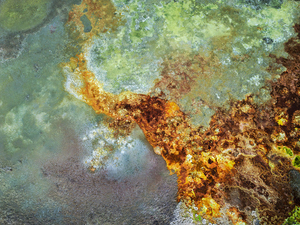EDWARD BURTYNSKY: AFRICAN STUDIES Now On View At Howard Greenberg Gallery

Edward Burtynsky's powerful new photography series African Studies, a seven-year project spanning ten countries, is having its New York premiere with two solo gallery exhibitions. The exhibitions are on view at Sundaram Tagore Gallery from March 2 through April 1 at 542 West 26th Street and at Howard Greenberg Gallery from March 4 through April 22 at 41 East 57th Street. African Studies is the subject of a 208-page monograph of the same title newly published by Steidl (2023).
Since the early 1980s, Edward Burtynsky has been photographing industrial landscapes across the globe, documenting in remarkable detail the human imprint on the planet through terraforming, extraction, urbanization and deforestation. For this project, he focused on Sub-Saharan Africa, traveling to Kenya, Nigeria, Ethiopia, Ghana, Senegal, South Africa, Botswana, Namibia, Madagascar and Tanzania between 2015 and 2020.
Burtynsky's interest in Africa was sparked 20 years ago while he was working on his landmark 2004 photographic project China, which explores the country's rapid globalization and the construction of the Three Gorges Dam. The series, and subsequent award-winning documentary film by Jennifer Baichwal, Manufactured Landscapes (2006), chronicle China's transformation into the world's leading manufacturer and depository for its waste. Burtynsky witnessed firsthand the immense environmental-and by extension, human-cost of development, and he predicted Africa would be the next, and perhaps the last, region to undergo major industrial expansion.
Presented in large-format photographs, African Studies conveys the fragility of the natural world, bringing together images of lush, undisturbed landscapes and environments irretrievably altered by industry. The series was largely photographed from aerial perspectives, a viewpoint that distills the continent's diverse topography into graphic patterns and gradients of sumptuous color. The resulting effect seemingly transforms the marks of human infrastructure into painterly abstract compositions. In these images, as in all his work, Burtynsky skillfully integrates critical reporting with sublime visual aesthetics creating a harmonious balance between content and form.
"With this project I hope to continue raising awareness about the cost of growing our civilization without the necessary consideration for sustainable industrial practices and the dire need for implementing globally organized governmental initiatives and binding international legislations in order to protect present and future generations from what stands to be forever lost," Burtynsky said.
Edward Burtynsky (b. 1955) is represented in the collections of more than 80 museums worldwide, including The Metropolitan Museum of Art, The Museum of Modern Art and the Solomon R. Guggenheim Museum, New York; Reina Sofia Museum, Madrid; Tate Modern, London; and the National Gallery of Canada, Ottawa.
Notable exhibitions include Anthropocene (2018) at the Art Gallery of Ontario and the National Gallery of Canada (international touring exhibition); Water (2013) at the New Orleans Museum of Art and Contemporary Arts Center, Louisiana (international touring exhibition); Oil (2009) at the Corcoran Gallery of Art in Washington, D.C. (five-year international touring show), China (toured 2005 - 2008); Manufactured Landscapes at the National Gallery of Canada (toured 2003 - 2005); and Breaking Ground produced by the Canadian Museum of Contemporary Photography (toured 1988 - 1992).
Honors include the inaugural TED Prize, the Governor General's Award in Visual Media Arts, The Outreach award at the Rencontres d'Arles, the Roloff Beny Book award and the Rogers Best Canadian Film Award. In 2020, Burtynsky was awarded a Royal Photographic Society Honorary Fellowship and in 2022, he was honored with the Outstanding Contribution to Photography Award by the World Photography Organization. Most recently he was inducted into the International Photography Hall of Fame and was named the 2022 recipient for the annual Pollution Probe Award. Burtynsky was born in St. Catharines, Ontario, in 1955. He lives and works in Toronto.
Sundaram Tagore Gallery has been representing established and emerging artists from around the world since 2000, championing work that is aesthetically and intellectually rigorous, infused with humanism and art historically significant. The gallery specializes in paintings, drawings, sculptures and installations with a strong emphasis on materiality. The gallery also has a robust photography program that includes some of the world's most noted photographers. Locations in New York, Singapore and a permanent space in London's Cromwell Place. For more information, visit sundaramtagore.com. Contact us at press@sundaramtagore.com or 212-677-4520.
Since its inception in New York 40 years ago, Howard Greenberg Gallery has built a vast and ever-changing collection of some of the most important photographs in the medium. The Gallery's collection acts as a living history of photography, offering genres and styles from Pictorialism to Modernism, in addition to contemporary photography and images conceived for industry, advertising, and fashion.
Formerly a photographer and founder of The Center for Photography in Woodstock in 1977, Howard Greenberg has been one of a small group of gallerists, curators and historians responsible for the creation and development of the modern market for photography. Howard Greenberg Gallery-founded in 1981 and originally known as Photofind-was the first to consistently exhibit photojournalism and street photography, now accepted as important components of photographic art. The Gallery is located at two 57th Street locations: an exhibition space on the 8th floor of the Fuller Building at 41 East 57th Street; and an entire floor at 32 East 57th Street, directly across from the Fuller Building, to house, manage and present its vast archive of over 40,000 prints.
For more information, contact 212-334-0010, info@howardgreenberg.com or visit www.howardgreenberg.com.
Videos

